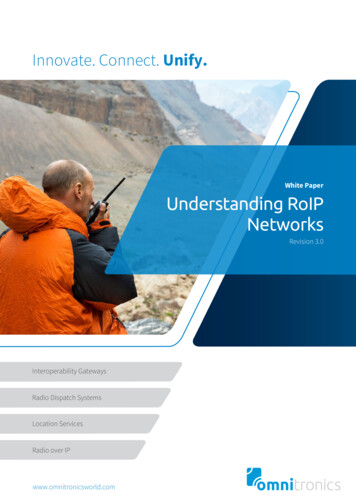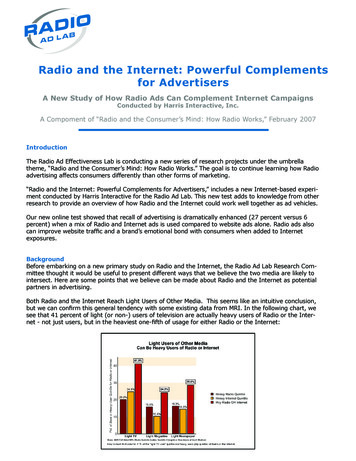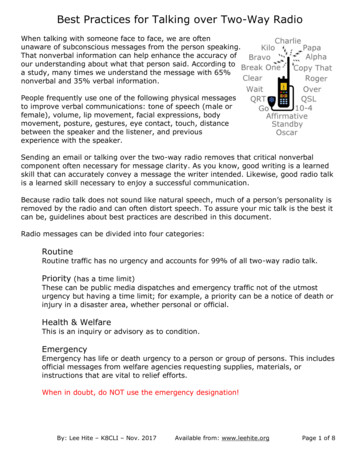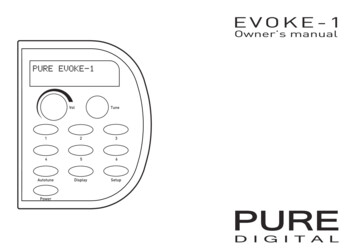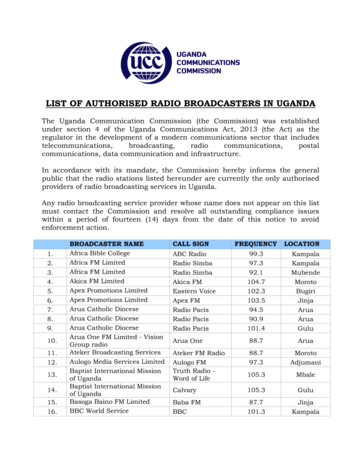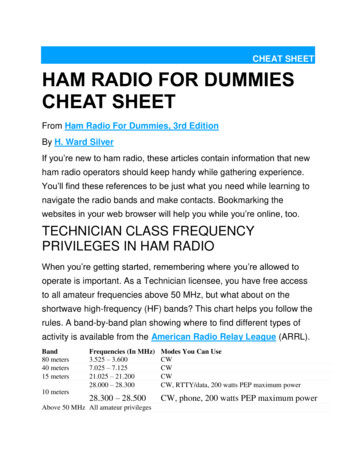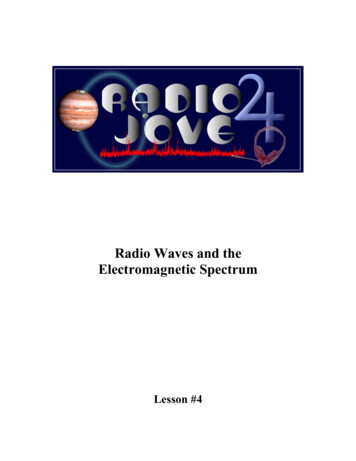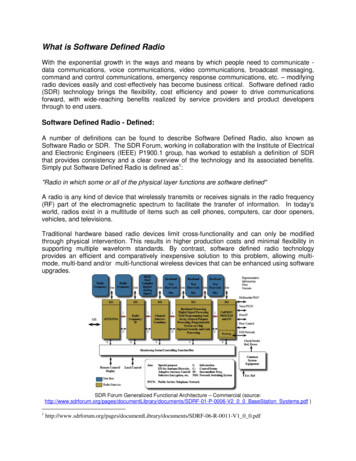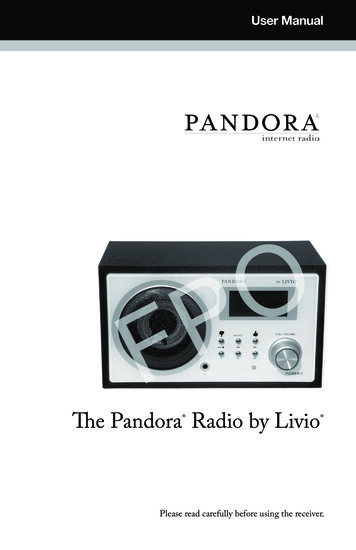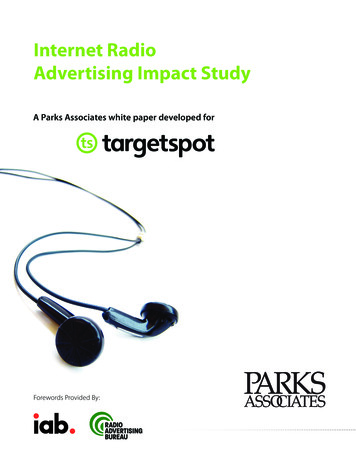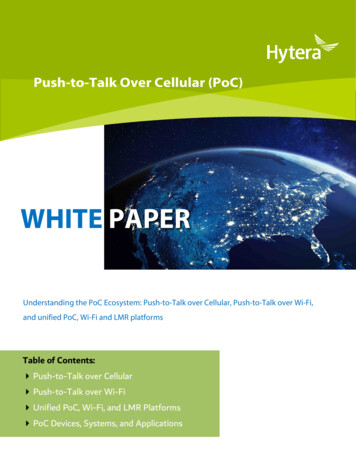
Transcription
Push-to-Talk Over Cellular (PoC)WHITE PAPERUnderstanding the PoC Ecosystem: Push-to-Talk over Cellular, Push-to-Talk over Wi-Fi,and unified PoC, Wi-Fi and LMR platformsTable of Contents: Push-to-Talk over Cellular Push-to-Talk over Wi-Fi Unified PoC, Wi-Fi, and LMR Platforms PoC Devices, Systems, and Applications
PUSH-TO-TALK OVER CELLULAR (POC)What is PoC?Push-to-Talk over Cellular (PoC) provides two-PoC utilizes LTE cellularinfrastructure to create awide-area radio networkthat provides nationalcoverage for voice andvideo communicationsway radio services over 3G, 4G, and Long TermEvolution (LTE) technology, creating a structure of Mobile Network Operators. Thisenables radio networks with very wide coverageareas. Radio users are untethered by the range ofrepeaters and base stations used in traditionalradio networks.The concept of Push-to-Talk over Cellular was introduced by Nextel in 1987 as an alternative to two-way radios.Nextel revolutionized business communication when it started to pass small voice packets across their iDENnetwork. Prior to PoC, business communication was dominated by two-way radios on peer-to-peer and localradio networks. Nextel was acquired by Sprint, and in 2013 Sprint decommissioned the Nextel iDEN networkbecause it could not support modern LTE data and video bandwidth requirements.Today, PoC provides the best of bothnarrowband digital radios and broadband LTEnetworks. PoC radios support the advancedfeatures of Digital Mobile Radios (DMR),including messaging, instant group calling, GPSlocation tracking, and emergency notifications.Combining this functionality with Wi-Fi and LTEcellular networks provides the , along with the national coveragearea of 4G/LTE.2
How PoC WorksPoC devices connect to the cellular infrastructure of Mobile Network Operators like AT&T, T-Mobile, andVerizon, using a SIM card similar to those installed in cell phones. The result is access to an existing and reliablenetwork that requires no maintenance or operational expenses. An app on the PoC radio (typically an Androidoperating system) provides simple and convenient access to PoC services.PoC network services are hosted in the cloud. The cloud services are located on privately hosted serversoperated by the PoC platform owner. Gateway routers provide connectivity between the LTE network and thecloud hosted PoC server. Dispatch Applications and the Management Application (used to configure customeraccounts) are connected to the PoC cloud server through the internet.PoC Group CallingPoC provides the same group calling capabilities as traditional two-way radio systems to enable instant groupcalls to multiple users with the press of a PTT button on a radio or from a dispatching application.Call groups are set up based on all call andemergency calls, types of employees(supervisors, administrators, etc.), remoteemployees and mobile service fleets,employee locations, type of projects, etc.Radio users can belong to multiple groupsas shown in the overlapping areas.3
PoC Market GrowthGrowth in PoC services is being driven not just by the LTE technology, but also by the increase in the globalmobile workforces, and the global adoption of the Internet of Things (IoT). At its peak, Nextel had over twentymillion subscribers, proving the demand for wide-area voice and data workforce communications.KBV Research, January 2020 - The Global PoC market size is expected to reach 43.8 billionby 2025, with the market rising at a Compound Annual Growth Rate (CAGR) of 10.1%.Research and Markets, March 2020 - The global PoC market was valued 21B in 2017 and isprojected to reach 55B by 2027 and grow at a CAGR of 11.2% during 2020-2027.Fortune Business Insights, June 2020 - The global PoC market value was 12B in 2019 andis projected to reach 25.5B by 2027 with a CAGR of 10%. North America is expected to leadthe market share during the forecast period. The projected growth declined due to the COVID19 pandemic.Who Uses PoC?Businesses which use PoC services are looking for wide-area workforce communications with a low start-upcost. PoC is particularly useful for businesses with vehicle fleets, as asset tracking via GPS is an integralcomponent of the PoC dispatch solution. PoC also provides a cost-effective solution for organizations wheretraditional Land Mobile Radio (LMR) solutions do not support broadband applications, and the availability oflicensed radio frequency spectrum is limited or unavailable. Security Guards Property Management Retail Hospitals and Healthcare Hospitality Contractors and Building Materials Bus and Transportation Waste Management Entertainment, Theme Parks, and Zoos Event Production Companies Food Distribution and Delivery Services4
The PoC OPEX vs CAPEX ModelTraditional wide-area private radio networks require significant up-front Capital Expenditures (CAPEX), thatinclude FCC licensing, and the cost of radio equipment hardware such as base stations, repeaters, routers, andantennas. PoC can be deployed from an Operational Expenditures (OPEX) budget as a low-cost, subscriptionbased service.PoC Features and BenefitsNationwide CoveragePoC leverages 3G/4G/LTE and Wi-Fi networks to provide secure, instant, and nationwide communications fortoday’s mobile workforce.No Infrastructure RequiredThere is no need to purchase, operate and maintain any infrastructure, as this is managed by the MobileNetwork Operators. This reduces capital equipment costs, day-to-day operating and maintenance costs, andeliminates the need for frequency licenses required by the FCC for private LMR systems.Rapid DeploymentsSince the communications network infrastructure already exists, PoC systems can be deployed very quickly.PoC radios can work out-of-the-box with SIM cards pre-installed, and system configuration is done through aneasy-to-use web-based dispatch application.Instant Push-to-Talk Voice and Video Group CallingPoC technology enables subscribers to make one-to-one (individual) calls or one-to-many (group) calls todifferent groups of people at the same time over Wi-Fi or a mobile operator’s network. One press of a buttonon a rugged handheld device and you are talking to your group or an individual. PoC devices with camerasand video capabilities enable instant picture messaging and video conferencing with individuals or groupsusing dispatcher applications.GPS Location TrackingPoC devices with integrated GPS enable location tracking via a dispatcher application. This is an essential toolfor managing, scheduling, and tracking remote teams in real time. PoC dispatch applications that support GeoFencing enable alarm triggers when, for example, employees enter hazardous areas, or when remote serviceemployees stray from defined territories. Dispatchers are typically web-based applications allowing for easydeployments and minimal start-up costs.5
PUSH-TO-TALK OVER WI-FIPoC devices also support Wi-Fi connectivity. This enables instant group voice and video calling in a largebuilding, facility, entertainment complex, or campus with Wi-Fi network connectivity, or within Wi-Fi networkhotspots.How PTT over Wi-Fi WorksPush-to-talk over Wi-Fi leverages the existing Wi-Fi network and access points throughout a facility, so there isno need to install traditional radio network infrastructure. The first step in a PTT over Wi-Fi deployment is toconduct a site-wide bandwidth audit to ensure there is enough coverage for the whole facility. Then a Pushto-talk over Wi-Fi a server is installed to provide system connectivity between the Wi-Fi network, the PoCdevices, and the dispatch application. The last step is to configure PoC devices with call groups and devicefunctions and distribute them to employees.A web-based dispatch application is used to initiate group voice and video calls from a single location. Dispatchapplications can also utilize the GPS capabilities built into PoC devices to track employees throughout a largeoutdoor facility like a convention center or entertainment complex (zoo, theme park, etc.).Push-to-talk over Wi-Fi is not limited to a single location. Several sites can be connected over an IP Network orVPN and managed from one or more dispatch applications. For example, a hotel and resort may have severallocations with Push-to-talk over Wi-Fi, and they want centralized call management and dispatching.Push-to-talk over Wi-Fi can also be seamlessly integrated with a nationwide PoC network to enablecommunication with remote and mobile workers. By adding a SIM card, PoC devices can automatically switchto an LTE network when a caller moves outside Wi-Fi network range.6
Push-to-Talk over Wi-Fi Features and BenefitsNo Infrastructure RequiredPTT over Wi-Fi uses existing Wi-Fi networks, so there is no need to purchase, operate and maintain any radioinfrastructure. This reduces costs and enables rapid deployments.Flexible Single-Site, Multi-Site and Nationwide CoveragePTT over Wi-Fi can be deployed as a single-site radio network, or multiple sites can be connected over an IPNetwork or VPN. PoC devices also function on nationwide PoC networks with the installation of a SIM card.No Radio Frequency Licenses RequiredPush-to-Talk over Wi-Fi eliminates the need for expensive radio frequency licenses, and in many high-densityurban areas there may be no frequency spectrum available.Push-to-Talk Voice and Video Group CallingPTT over Wi-Fi provides the same instant group calling capabilities as PoC systems, including group videoconferencing with devices that support video.GPS Location TrackingPoC devices with integrated GPS enable location tracking via a dispatcher. This is useful in large campuses orentertainment complexes for managing, scheduling, and tracking employee locations.Who Uses PTT over Wi-Fi?Wi-Fi is nearly ubiquitous in all buildingsand facilities and enables companies toleverage their existing investment inWi-Fi infrastructure. Hospitals Schools and Universities Convention Centers Office Buildings Factories and Warehouses Hotels and Resorts Theme Parks, Zoos, and Aquariums Museums and Art Galleries7
UNIFIED COMMUINICATIONS PLATFORMSUnified communications platforms integrate different radio systems into a single wide-area radio network withinstant group calling and location-based dispatching.Expand the capabilities and rangeof existing radio networks byintegratingPush-to-TalkoverCellular and Push-to-Talk over WiFi networks into a single voiceand video radio communicationsecosystem.How Unified Communications Platforms WorkVirtually any radio communications network can be integrated into a unified communications platform. Theseinclude PoC and Wi-Fi networks, DMR Tier II and Tier III, TETRA, P25, NexEdge, dPMR, and even legacy analogradio systems.8
Unified platform management and dispatch applications enable communication with groups of users acrossseveral types of radio networks. Voice and video calling groups can be created that include several types ofradios and networks, and users can belong to multiple call groups.These unified platform applications provide public-safetygrade dispatching and fleet management, voice and videogroup calling, call recording, AVL, and camera monitoring.The powerful dispatching client allows the managers anddispatchers to quickly command all users in differentnetworks with Simul-Select and Crosspatch capabilities.In the example shown below, a company has two large facilities at different locations. One has a Push-to-Talkover Wi-Fi network, the other a traditional Digital Mobile Radio (DMR) trunked radio network. The companyhas added a PoC radio network for a mobile workforce. By using a unified platform management and dispatchapplication, and installing a unified platform server, the existing PTT over Wi-Fi radio network, the LMR radionetwork, and the PoC network are integrated into a single, unified wide-area radio network that covers a widearea in and around both facilities. The DMR radios, the PoC devices, and the BYOD devices are all on the samecommunications system with call groups that include all the different types of radio technologies.9
The Benefits of Unified Communications PlatformsCentralized Communications and DispatchingCentralize operations by integrating different radio networks into a unified communications managementplatform that improves efficiencies and communication within large organizations. Use a one centralizeddispatch application for location tracking and group communications across a single system.Reduce CostsEliminate the need for system-wide upgrades and maintain investments in existing radio equipmentby integrating current radio systems with PoC nationwide and Push-to-Talk over Wi-Fi networks.Group Voice and Video CallingSupports instant, system-wide group voice and video calls, group patching, broadcast calls, priority calls, andcall monitoring. Video conference and share videos between dispatch and remote users.10
POC DEVICES AND SOFTWARE APPLICATIONSHytera HALO is a suite of PoC systems that provide network access, PoC devices, and dispatch applications.Hytera HALO Nationwide is a PoC solution with wide area connectivity over cellular 3G/4G/LTE networks, andHytera HALO OnSite is single or multi-site Push-to-Talk over Wi-Fi system. The Hytera HALO Nationwide andOnSite systems are complementary and can be deployed with both local coverage and wide-area coverage.Hytea HALO Connect is a unified LMR and PoC platform. The Hytera HALO Android app is available for BringYour Own Device (BYOD) smartphones.Hytera PoC RadiosThe Hytera PNC370 and PNC380S PoC radios are purpose built for businesscommunications. These compact, rugged, and easy-to-operate handhelddevices enable group voice and video communications over nationwideLTE cellular networks. Digital noise suppression and high-volume speakers for excellentvoice quality in loud environments Built-in Wi-Fi that automatically switches over to the LTE networkwhen out of Wi-Fi range Built-in Bluetooth supports wireless connection with audio accessoriesfor hands-free operation GPS enables tracking and positioning for the dispatching application Ruggedized to IP55 (PNC370), IP67 (PNC380S) and MIL-STD-810 G standards Supports individual or group texting Powerful battery provides up to twenty-four hours of operation In addition to these features, the PNC380S features a built-in camera, full keypad, and is AT&T networkapproved11
A car kit is available for the PNC380S PoC radio and provides safe and DOT approveduse in vehicles. The key advantage is that it enables the PoC device to be used insideand outside the vehicle. The car kit is installed on a vehicle dashboard and enableseasy removal of the handheld device for job-site communications. The car kitincludes a locking bracket to ensure drivers who work inside the vehicle use theradio as a dash-mount mobile radio and not a handheld device. The car kit providescharging power, has an on/off button, and ports for external speakers,microphones, and push-to-talk buttons.Hytera PoC SmartphonesThe Hytera PNC550 is a Push-to-Talk over Cellular (PoC) smartphone designed fornationwide business communications. The PNC550 combines the advantages of asmartphone with the ruggedness, enhanced audio quality, and instant Push-to-Talkgroup communications of a professional PoC device. National wide-area communication with mobile 3G/4G/LTE connectivity Built-in Wi-Fi supports in-building communications with seamless switching toLTE networks when outside Wi-Fi range Push-to-Talk button initiates instant voice or video calls to groups or individuals Rugged design with Gorilla Glass display, MIL-STD-810-G compliance for shockand vibration, and IP68 rated for complete water and dust resistance Features a 13MP rear camera with flash and an 8MP front camera for video calling with the Hytera HALODispatch application and other PoC devices Digital, dual mic noise suppression and high-volume speaker for excellent voice quality in loudenvironments Dual SIM cards provide flexibility for two network access plans, one for PoC and the other for a cellularplan or data-only plan GPS enables real-time tracking and positioning for the Hytera HALO Dispatch application Supports Android apps and can run the Hytera HALO Dispatch web-based application. Open API and SDKallow third party developing customized applications Powerful 4,000mAh Lithium-Ion Polymer battery delivers up to 24 hours of operation12
Hytera PoC Body Worn CamerasThe Hytera VM780 Body Worn Camera integrates a body camera with Push-to-Talk over Cellular (PoC) voicecommunications to capture, store, and share video, audio, and image evidence in the field. The VM780features video transfer, evidence collection, and dispatching software applications. All-in-one design reduces equipment costs andsimplifies communications Full duplex voice calling and video conferencing 2.8-inch touch display HD 1080P video recording with AES256advanced encryption Stream video over 4G/LTE or Wi-Fi networks fornationwide monitoring of events GPS built-in and Hytera HALO Dispatch application compatibility Supports individual and group calls between dispatch, VM780, and other POC devices IP68 and MIL-STD-810G rated Powerful battery life supporting up to nine hours of continuous recording Features an optional six-unit charger that enables simultaneous charging and automatic video transferfrom up to 18 bodycamsHytera HALO DispatchHytera HALO includes a powerful web-baseddispatch and fleet management applicationthat tracks driver locations and travel routeswith time stamps. The dispatch applicationworks with the GPS built into Hytera PoCdevices and supports geofencing capabilities.Hytera HALO Dispatch supports instant group calling as well as individual calling. Dynamic call groups can bequickly created with a simple list selection or geographically by selecting an area on the dispatch map. Thedispatcher may stun (turn off) and reactivate a radio, and receive emergency alarms.13
PoC Devices vs. SmartphonesEmployees can use personal smartphones, company issuedsmartphones, or PoC radios, PoC video bodycams, or PoCsmartphones for internal company business communication.BYOD smartphones can be used as PoC devices with an Androidapp installed on the device.VSCompanies may prefer to have some or all employees usingsmartphones for business communications, but there are severaladvantages to providing employees with dedicated PoC devices. PoC devices and service plans are less expensive than smartphones and cellular plans Ensures employees use the devices exclusively for business-related communications and reduces thedistractions of personal smartphones Instant Push-to-Talk group and individual calls without launching apps, looking up contacts, or waiting forthe phone to ring Rugged devices that withstand high impact (dropping), water submersion, and dust High power batteries that guarantee calling availability for the entire work shift High volume and noise cancelling technology for use in noisy environments One touch emergency alarms for worker safety Car mounting kits are available for DOT approved use inside vehicles14
SUMMARYPush-to-Talk over Cellular is a disruptive technology that is creating a new market and value network that willcreate shifts in the market for established companies, products and alliances. As cellular LTE and Wi-Fi networkscontinue to mature, providing better coverage with more available bandwidth, PoC will continue to grow anddisrupt the established Land Mobile Radio (LMR) market. PoC systems provide key advantages, including wide area coverage, rapid deployments with no radioinfrastructure or FCC licensing expenses, dispatching and GPS location tracking. PoC devices are ruggedized for industrial applications and enable instant individual and group pushto-talk communications, video conferencing, data services, and Wi-Fi connectivity. Push-to-Talk over Wi-Fi leverages the ubiquity of Wi-Fi networks for quick and cost-effectivedeployments, and do not require frequency spectrum. Unified PoC networks enable centralized communications with nationwide coverage that integratesvirtually all types of radio networks into a single business communications ecosystem.PoC cellular technology, and ability to integrate PoC with Wi-Fi and LMR radio networks provides the flexibility,low cost, and wide-area coverage required for modern workforce communications.15
About HyteraHytera is a global leader in research and development, state-of-the-art manufacturing, and bringing nextgeneration radio technology to the market. Hytera has ten international R&D Innovation Centers and morethan 90 regional organizations around the world. 40% of Hytera employees are engaged in engineering,research, and product design.Since its founding in 1993, Hytera has established itself as a innovating provider of wireless communicationssolutions for the government, transportation, commercial, and industrial sectors. Hytera America offers a fullsuite of two-way radio products and communication solutions to meet any demand and budget. DMR Two-Way Radios Push-to-Talk over Cellular Devices and Systems Analog Two-Way Radios Biometric Access Control and TemperatureScreening DevicesHytera is the fastest growing radio communications company in the world.Hytera AmericaHytera .hytera.ca949-326-5740 (US West)905-305-7545800-845-1230 (US East) 2020 Hytera America. All rights reserved. Hytera and the Hytera logo are trademarks of Hytera Communications Co., Ltd.Other trademarks are held by their respective companies.16
Verizon, using a SIM card similar to those installed in cell phones. The result is access to an existing and reliable . Virtually any radio communications network can be integrated into a unified communications platform. These include PoC and Wi-Fi networks, DMR Tier II and Tier III, TETRA, P25, NexEdge, dPMR, and even legacy analog
